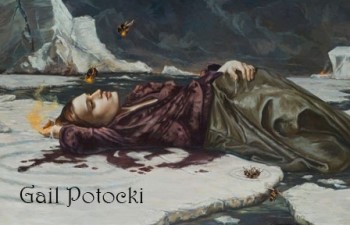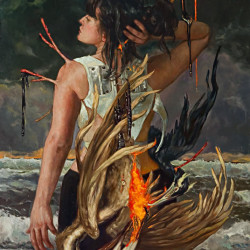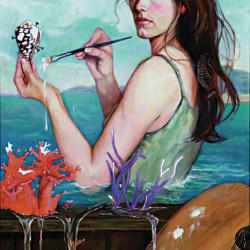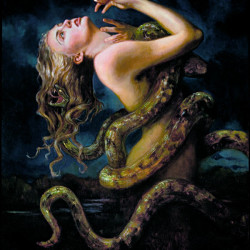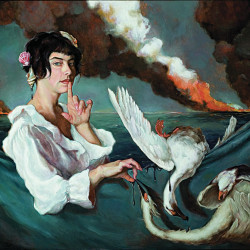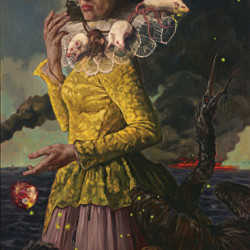Q: Tell me something about your history in the creative arts. Did you have a formal school education or are you self taught?
A: I was a late bloomer when it came to becoming an artist since I didn’t paint my first painting until I was almost 40 years old! I grew up an “only child” so I spent much of my childhood alone.
When I wasn’t catching snakes at my grandmother’s farm or building forts in the woods, I was drawing and making things. I never considered art as a career, though,and spent most of my working life working in unfulfilling jobs. Then I stumbled upon a classical drawing and painting atelier in Chicago, where I spent 4 wonderful years. I am forever grateful that painting finally found me!
Q: We’re interested to hear about your basic inspirations that drive your creative energies.
A: My inspiration changes over time. For many of my paintings, I focus on themes of nature, the environment, and humanity’s effect on it. I also have an interest in the more unusual aspects of nature, which has led to a series on circus sideshow “freaks”. I think my focus right now is on the paint, and act of painting itself, as opposed to subject matter in that I am exploring how to express my ideas more with the use of brushwork and color.
Q: What were the circumstances that planted that first creative spark in you, and how is that tied to your current inspirations?
A: Well, like a great number of artists, I was an extreme introvert when I was young, and was much more comfortable “conversing” with the animals at grandma’s farm and with my pets than I was with other children. This led to me having a great amount of empathy for non-human creatures and has fueled my environmentally related paintings. I realize that art can’t change the world, but I always have hope that it can at least help put the seed for change in peoples’ minds.
Q: Was there a particular person in your past that nurtured your creative instincts, like an artist, or a teacher, or mentor of some kind?
A: While I was working at one of my less inspiring jobs, I took a night class at the local community college in drawing/painting. That particular instructor was so encouraging to me, and really pushed me to pursue an artistic path more seriously. His words had such a profound effect on my life!
 Q: How do you feel that creating your “art” is a part of your lifestyle, and life’s plan for you?
Q: How do you feel that creating your “art” is a part of your lifestyle, and life’s plan for you?
A: At this point, there is no separation between me and my art. It is the purest and most encompassing way that I express myself.
Q: How has your creative nature influenced your personal relationships?
A: Since I’ve been working full time as an artist, I’ve come to have more friends that are also artists. I suppose this is true for most people – that they gather with other like minds. It’s energizing for me to be around other creative people, and I love to get critiques of my work from them and discuss ideas, because it can only make the work stronger. On the other hand, painting is a very solitary occupation and it tends to coax out my introverted nature. I have to fight this quite often and force myself to go out and be social. If not, I may end up being one of those crazy old ladies that walks around all day muttering to her 40 cats!
Q: What is a typical day like for you?
A: Feed the dog, the cats and the goldfish, eat breakfast and then go out in the studio. On nice spring and summer days I alternate working a bit in the studio and working in the garden. I love to dig in the dirt!
Q: Do you have personal partnerships with others connected to your creative sense? Can you speak a bit about that dynamic?
A: I am fortunate to have a few people in my life that really understand what I do and are very supportive of me. Particularly, one is my art dealer and the other is the person that helps me make my frames. I wouldn’t be able to create the work that I do without them.
Q: Say something about the decision making process in your approach to what you do.
A: I throw a lot of ideas around and write them down. (For some strange reason I never sketch and have never been a doodler). I let them set for a while until I can look at them again with a fresh mind, then I start editing. I try to walk a line between having a narrative, yet keeping the paintings open and poetic.
Q: Do you ever want to get away from it all? What do you do for release, and to shake out the cobwebs of energy spent?
A: Eat and shop.
Q: How important, in your art, is the message, as in, imbedding a literal purposeful message into your artistic aesthetics?
A: There is usually a message in my work wrapped in symbolism. Sometimes I do this more for my own sake than for the audience’s, and I don’t always expect or need the viewer to get what my painting means. I just have a difficult time making purely decorative work, and enjoy the challenge of creating an allegory or puzzle in my paintings which I feel adds richness and layers to them.
Q: How do you feel living in your city/town/country, affects your creative energies or influence your work?
A: Right now I am spending most of my time living in the middle of nowhere in small town Michigan. I decided on this move after spending the past 25 years living in Chicago. It’s been positive for my art because it provides me with the silence that I need in order to hear my own inner voice, and surrounds me with the nature that I cherish and frees me of distractions. There is not much else to do out here so I get lots of painting done.
Q: What do you think of art as activism?
A: Anything that helps create positive change is a good thing!
Q: Do you have upcoming projects that you’re inspired with?
A: Yes, I am currently working on my interpretation of “Alice in Wonderland” which will be shown at Century Guild Gallery in LA this August.
Q: What is your idea of success?
A: To feel that I am being the best person that I am capable of being, and to use whatever talents or abilities that I have to create something beautiful. If I can do that throughtout my life, then I will feel that I have been successful.



